Need of E-Recruitment System for Universities: Case of Pulchowk Campus, Nepal
Volume 5, Issue 5, Page No 902-912, 2020
Author’s Name: Vijay Yadava), Ujjwal Gewali, Suman Khatri, Shree Ram Rauniyar, Aman Shakya
View Affiliations
Pulchowk Campus, Department of Electronics and Computer Engineering, Lalitpur, 44700, Nepal
a)Author to whom correspondence should be addressed. E-mail: vizayyadav123@gmail.com
Adv. Sci. Technol. Eng. Syst. J. 5(5), 902-912 (2020); ![]() DOI: 10.25046/aj0505110
DOI: 10.25046/aj0505110
Keywords: e-recruitment, job recommendation, candidate filtering, HR management
Export Citations
This paper highlights the importance of on-campus online job recruitment system and its role in helping students grab the available job opportunities. It highlights the problems associated with the traditional way of hiring, especially for college students. It also presents some findings and results obtained through various surveys conducted within the campus before and after the deployment of this system. The work presented in this paper is based on an e-recruitment system built for one of the leading engineering institute in Nepal, Pulchowk campus. With some features like job recommendation based on various levels of skill, smart multi-criteria search, graduate tracking, this system proves to be useful for all i.e. companies, students and the campus as well.
Received: 30 August 2020, Accepted: 28 September 2020, Published Online: 12 October 2020
1. Introduction
With an increase in production of manpower in various sectors, finding a proper job according to our skill is really a tough task to accomplish. Traditional method of hiring a candidate is proving to be inefficient. It is quite tedious and time consuming. Specially, those candidates who are freshers, don’t have any idea regarding the whole process from advertisement to hiring face difficult times in landing to their first job. It’s not that they don’t have the right skills required for the job, rather most of the time its lack of right information at right time. Some sectors of job are really competitive and is difficult to make through it. But many other sectors have plenty of job opportunities, it’s the lack of proper communication channel between employer and job seeker which makes it difficult. The advancement in electronics devices, IT sectors made people realize the need of e-recruitment system. In the beginning phase of development of e-recruitment system it was limited to only few countries and sectors. But today, it has widespread. Even the under developed and developing countries are working to build a proper electronic medium of hiring candidates to manage and mitigate the challenges posed by increasing unemployment in the country, to some extent.
In many developed countries, the universities and campuses have built their own job portal to make it easy for their students to get internships and jobs. This helps students know about the available opportunities at the right time and also establish proper communication channel with the employer. The employer can get their targeted candidate with little effort and less spending. The campuses can also be happy with the improvement in placement rate of their students.
Nepal has a range of web portals that work in the field of hiring of candidates for the jobs that they get through various companies from across the country. JobsNepal, KantipurJob, kumariJob, MeroJob are few of them. Though these commercial jobs are available in large numbers, the concept of job portal for universities and campuses is still a new idea to this country. It’s hard to find such a portal in the institute of this country. Through the study and understanding of the importance of dedicated job portal for campuses we came up with the idea to develop an e-recruitment for our own campus. Before developing this system, we conducted surveys among the bachelor’s students from the faculties of electronics, computer, electrical and civil engineering. The purpose of these surveys was to know their difficulties faced with traditional system, experiences of using available commercial job portals and perception towards having on-campus job portal.
Here, we are going to present a graphical representation of the process of hiring students that existed before this system and that exists after this system.
1.1. Before this system
The Figure 1 below depicts the traditional process of hiring of students that existed in our campus.

Figure 1: Traditional hiring process
In traditional system, in order to hire students, the company either contacted to various departments of our campus or Class Representative (CR) to circulate the information among students regarding any job vacancies. The department through CR and CR through Facebook page circulated that information. And then when student opened that page, they came to know about any job vacancies. The Facebook page was used for various purposes due to which the job-related information could not be properly communicated.
1.2. After this system
The Figure 2 shows the improvement we brought through the development of this system in the process of hiring students of the campus.
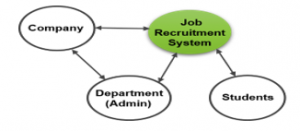
Figure 2: Present day hiring process
As shown in the figure above, a dedicated system is available to manage all the recruitment related activities. Now, company can directly post jobs in the web portal and students can see all the job postings in that portal without anyone’s intervention. Companies will contact the department only once in their whole lifetime i.e. at the sign-up process just to verify their identity so that they can start posting jobs and communicate with their potential candidate directly.
1.3. Why this system?
Even though many commercial job portals were available in the market, why we felt the importance of building this system, what edge this system provides over those commercial job portals and how it will benefit the students, we will answer these questions in this section.
Let’s have a look at a Figure 3.

Figure 3: Purpose of the system
According to the trend we have seen in last few years, when it comes to hiring a college student for the job, companies prefer students of one institute over others. Also, they post the same vacancies across variety of commercial job portals which is quite costly and time-consuming process. Now, they can simply post their job vacancies in our e-recruitment system which is not only free of cost but also reduces their time in the process of hiring the right candidate. Because it’s a simple system with limited user access, the campus also can manage to run this system in free of cost because in the end, it’s going to benefit their own students and themselves as they can keep track of the employment situation of their students.
2. Literature review
This paper is an extension of work originally presented in a conference, Artificial Intelligence for Transforming Business and Society (AITB), 2019 [1]. It contains an extensive explanation of the system using various diagrams. Some features which were improved in the system in the last one year have been included in this paper. Those improvements are job recommendation not only based on skills but also on the level of skill like beginner, skilled, advanced and expert, skill verification of students by the department, viewing the location of companies on map, knowing more about the location from where the job has been posted using Foursquare API. It also includes the analysis of data collected before and after the development of this system, through various surveys conducted among the students of the campus. Some data visualization tools have also been used to visualize the skill requirements of the country and places with more job opportunities across the country, using the data collected over the last one year.
Over the last few years technologies have developed a lot. But before that various traditional methods like advertisement through radio, television, newspapers were used to propagate information regarding vacancy opening [2]. Nowadays, people spend more time on internet finding a job rather than reading a newspaper or listening a radio every day. Many breakthroughs are being achieved regarding the speed of the internet which in turn have decreased the price of web surfing. At the same time, we cannot deny the existence of traditional way of hiring a candidate. Still, the same process of publishing an advertisement on newspaper and hiring a candidate through an interview is considered as the best way to find the right candidate [3]. The major role of online recruitment system is to communicate information regarding the vacancies among the targeted candidates within the right time and in an organized manner in order to fight the increasing unemployment because in some places where even jobs were available, the candidates were unaware of those jobs due to lack of proper communication channel [4]. So, it becomes very important to study the existing situation around the place for which the system is being built. A proper study is needed to know the perception of both employer and job seekers especially the students regarding online recruitment system and traditional system of hiring [5]. Not all the employers looking to find candidate for the job through online process gets satisfactory result after spending considerable amount of money during the process [6]. So, once a system is built it is necessary to analyze the various parameters of the system like cost-effectiveness, security, performance, usability and reliability with the help of group of respondents who are actually going to use the system [7]. Charging a huge amount of money to the employers/ companies is not going to help, especially in the case of on-campus job portal because this will ultimately reduce the number of job postings through this system.
Knowing the purpose of building a job portal is very important because in the past as well many job portals emerged without analyzing the environmental situation required at that point of time and thus, later on were compelled to merge in order to provide better service [8]. Online job recruitment system cannot be useful in every scenario. There are some problems associated with e-recruitment system as well [9]. In some cases, it may prove to be more costly and inefficient. So, while developing a system all factors need to be considered. If done so it can save large amount of money which is spent on advertising and those saved money can be used for training and skill enhancement of the hired candidate [10]. Campuses where mostly non-income generating candidates are available, cost effective system is a must to reduce the economic burden which could come upon the student.
In a fast-paced world of today, it’s very difficult to carry on the traditional way of hiring a candidate they are tedious, time consuming and stressful [11]. We live in the world of advertisement. No matter how good the product is, it needs an attractive presentation through advertisement to increase its sale and get desired price for that product. Same thing applies for job. It is directly linked with the life and dreams of an individual. So, he/ she needs to find something inspiring to apply for a job and an e-recruitment provides that platform to the employer to put a proper job posting in order to attract the targeted candidates [12]. Online medium and internet have brought drastic change in the recruitment process impacting both employer and job seeker in a positive way. Internet has become a major tool for both employer and job seeker as it has brought both of them on same platform. It has revolutionized the traditional method of hiring a candidate for the job [13]. It provides an edge to the company to get the best candidate suited for the job. Also, an edge to the job seeker to select from many options available. E-Recruitment system has virtually vanished the boundaries between the countries [14]. It has promoted the concept of globalization. It has reduced the work and time spent by Human Resource Department of companies on hiring process, significantly. It has made the whole process organized and paperless [15].
An individual has to go through various steps and screenings before they finally get a job and for that one should first be able to apply for a job of matched skills [16]. Companies perform those screenings to make sure they have found the right candidate who could sustain in the company for longer period of time because the human resource is what one company can have advantage over others [17]. Skilled and talented human resource makes wise use of resources available within the company and thus makes a company look different in comparison to its competitors. The human resources available within the company should be motivated and possess high morale and companies should help them with these because the conduct, work and efficiency of workforce of companies determine the survival of the company in the business they are involved in [18].
Lots of job are posted on an e-recruitment website on a daily basis. All the job seekers on those platforms don’t have same set of skills and it takes lots of time for an individual to find the right job that match up with his/ her skills, if some mechanisms are not employed in the system to recommend jobs to the job seekers based on the skills they possess [19]. So, recommendation system is a must for any e-recruitment system because the main purpose of any e-recruitment system is to reduce the time in the process of hiring.
Nepal is still a developing economy. Many skilled manpower is forced to leave the country in search of job. So, a better and organized system is required to employ those workforces within the country to contribute to its economic development [20]. And, what could be a better than to start identifying the skill of individuals during the college times and helping them find the job that suits their skill. This will not only stop those skilled workforces from going abroad but also help them in contributing to the development of their own country. The college students are more in dilemma when they complete their study and look to find a job for themselves because they don’t have any idea regarding where to apply, how the process takes place. They spend much time finding answer to those questions before they land to their first job. So, the e-recruitment system we have built will try to solve these issues. With this system, students will probably be able to get their first job before they complete their studies. Also, they would be familiar with the whole process in advance.
3. System overview
This application is a campus based online recruitment system. The need to build this system was realized when we faced with the traditional method of hiring students by the companies. The traditional method was time consuming, tedious and unfair to most of the students because the job vacancies came through various individuals in the campus. There was not a dedicated platform for handling only job-related matters due to which the information related to vacancies could not reach to every students of the campus within the time. In fact, we faced this issue multiple times. Until we could get information related to vacancies, some other individuals were already hired. So, we thought of building a system which would treat each student fairly in terms of getting information timely and show casing their skills to the employer. We also defined the role faculty department (Admin) during the hiring process, in this system. There are three actors involved in this system. They are students, companies and faculty departments. Though the role of faculty department during hiring process is minimal, it’s vital.
3.1. Basic features of the system
The basic and most important features of an e-recruitment system is shown in Figure 4 The system will help students to build their profile once they are logged in and this profile can be used to generate CV which they can download in the form of PDF. The companies can post job through their own profile. Based on the jobs posted by the companies, the system will recommend the jobs to the students that match with their skills. A secured login is provided to enhance the authenticity of the users.

Figure 4: Overview of system
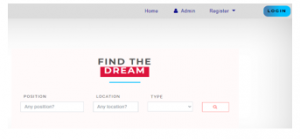
Figure 5: Home page of the system
3.2. Workflow of the system
The state diagram shown in Figure 6 represents various states and the workflow of the system. During the sign-up process, users need to identify themselves as either employer or student. Department does not have to create a separate account as it is already provided with the system. Students having an email account of the campus will only be allowed to create an account. Similarly, the companies can also create an account which they can use to post job vacancies. Students, Companies and Admin are the three actors involved in this system. The whole process of hiring is completed with interactions among these three actors.

Figure 6: State diagram of the system
The role of all three actors are elaborated below:
Students
Students are the job seekers in this case. All they have to do is to first register themselves into the system. During the registration process, students need to verify their email address. This process does two things, first it verifies whether the email address used is of the campus or not (for e.g.: abcd@pcampus.edu.np), and the next thing is whether the provided email address is associated with particular user or not. The link sent to email for verification will be valid for only few hours. Once the email is verified, users will be asked to update their profile. After updating their profile, they can apply for the job. Also, students will now be visible to the companies in their search results. Students will be notified periodically through email to update their profile to increase the chances to find better job.

Figure 7: List of jobs the student has applied for
Companies
Companies are the job providers or employers in this case. All they have to do is to create an account to start posting jobs. They have to pass through two verification processes. First, they have to verify their email address and the second is to verify their identity which will be done by the Admin. Once an account is created, a notification will be sent to the Admin to verify whether the company is genuine or not. The admin can match the information provided by the companies during the creation of account or can directly contact with the companies to verify its existence and credibility. As soon as the two-verification processes are completed, companies can start posting jobs. There is no limit on how many jobs a company can post. Also, the posting of jobs will be free of cost to attract sufficient job opportunities towards the campus.
Department (Admin)
It is the center of the system. It controls all the activities of the system. The major task of this actor is to verify the identity of the companies signing up into the system. It can also keep track of the employment condition of the students even after their graduation.
The role of Admin has been extended from the previous version of the system. A separate account will be setup for project supervisors which will have very limited access control over the system. The one who has logged in using this account can only view an interface to verify the skills of the students. Once in a semester the project supervisor can use this account to verify the skill demonstrated by the student during the development of project. Student’s profile will have green tick mark displayed along with their skills. This will be an added advantage to the student.
3.3. Software Development model
This application has been developed using prototype model. Since this system was itself a first of its kind in the country, it was very important to incorporate the feedbacks of various parties involved in this system directly of indirectly. Especially, it was very important to get the advices of the users who will actually be using this system. After refining so many prototypes, we finalized a prototype and started building this system. During prototyping, various faults within the design were identified. Also, it became easy for us to train them as most of them were familiar with the design. It also increased the acceptance among the users. The development and testing of the system were carried out simultaneously.
4. System architecture
The various components of this system have been elaborated below:
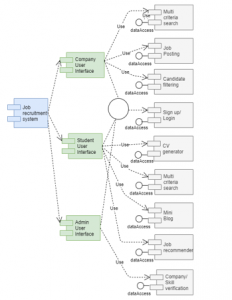
Figure 8: Component diagram of the system
Multi-criteria search
Multiple fields have been provided to both students and companies to make search. Students have been provided with fields like position, location and type to find the jobs more suited to them. Student can search for different positions like programmer, graphics designer, project manager, content writer and so on. Also, they can make search if jobs are available in the location of their choice. Type field represents the type of job like part time, full time, freelance or internship. Students can either use these fields individually or in combinations to make search.
Similarly, companies are provided multiple fields to make search for candidates best suited for the vacancies they have announced. The fields provided in search module of companies are position, qualification, skills, and years of experience. Position has same meaning as that of students. Qualification could be the degree that a particular candidate holds such as Bachelor in Computer Engineering, Masters in Electronics and communication Engineering and so on. Skills could be technical skills like python, java and non-technical skills like communication, time management and so on. The companies can also use these fields individually or in various combinations.
Not every time the keywords used for searching match exactly to the keywords stored in database. So, Levenshtein distance has been used to approximate the search keyword. It helps to find the result that best represents the keyword entered by users during search process. It calculates the minimum edit required to transform one string to another [21]. The edit mentioned here could be insertion, deletion or substitution.
For example, let us consider someone is trying to make search using skill field and he/she enters PYTON instead of PYTHON.
| P | Y | T | H | O | N |
| P | Y | T | O | N |
The Levenshtein distance between those two words is 3 as three changes are required. Also, we have fixed the maximum permissible to 3. So, in this case the user will successfully get all the results have skill value “PYTHON”.
Job posting
This allows a company to post jobs. There is no limit on how many jobs a single company can post. Also, the posting of job is free of cost. The company needs to add their address very carefully because we have used folium library to point to the address defined by the company, on map of Nepal. This could help student in finding the place easily in case if company calls that individual for the interview. Geopy library has been used to find the latitude and longitude of the place.
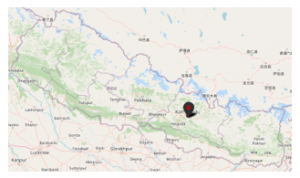
Figure 9: Example of map pointing to the address of company in New Baneshwor, Kathmandu, Nepal
There is also one feature provided called “Explore this place” which will help students get an overview of the place for which the job vacancy has been announced. It uses Foursquare API to find the top ten categories of venues within 500m of that place (if available within its dataset). Since it is still in an initial phase, the free version of Foursquare API has been used. Here also, Geopy library has been used to find the latitude and longitude of the place.

Figure 10: Fetching venues using Foursquare API
The venues fetched in JSON format is properly formatted and displayed in tabular form. Then, according to the availability of each category of venues, they are sorted in descending order to get the list of top ten categories of venues.

Figure 11: Example of top 10 categories of venues within 500m radius of Kathmandu fetched by Foursquare
Candidate filtering
The company after receiving applications from many students regarding any job vacancy can shortlist the students based on their skill, qualification and experience required for the job in order to reduce the time for recruitment. They can also download the CVs of shortlisted students.
Registration/ login
This component is responsible for allowing the users to safely register and log in into the system. During the process of registration or login, it is very important to make sure authentic users are using the system. The number of attempts allowed to make to login into the system have been set to four. Also, for new users the time interval to verify the email has been set to a maximum one hour. Failing to do so will result in suspension of the account in both the cases which could only be activated by the Admin. Also, the password strength is checked during the registration process and during the password change.
CV generator
This component is built for students. It is used to generate CV using the information provided by students during profile creation. Five attractive templates have been provided using which CV can be generated. The generated CV can be downloaded in PDF format as well to use it outside this system. The information displayed on CV would be basic information, education, experience, projects, hobbies, certifications and trainings, skills and languages. Company, if finds the profile of any student interesting can also download his/her CV in PDF format for future reference. This feature saves time and money of students which they spent on various platform for building an attractive CV.
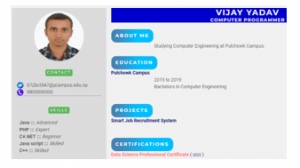
Figure 12: Example of a generated CV
Mini blog
This feature is provided to students which allow them to add short description of what projects or research they are working on. The companies can view these pieces of information when a student apply for the job to their company or when the company search for candidates using search component. Very limited functionalities have been provided with this component to keep it simple and yet useful.
Job recommender
Many jobs are posted in an e-recruitment system on a daily basis by different companies requiring different skills for different jobs. Every student/candidate doesn’t possess same set of skills. It would be difficult for them to find the right kind of jobs suited to their skill. So, a recommendation system is a must for any e-recruitment system. Student does not need make search every time they login into the system. In fact, the system itself recommend some jobs to the students based on the skills they have mentioned on their profile. The system first matches the skills of students with the skill required for the job posted and if matched, it will then look for level of skills i.e. beginner, skilled, advanced or expert, required for the job and also possessed by students. The jobs whose both requirements matched with the profile of students will be displayed on top in the recommendation section. The recommendation section is displayed on the home page of students.
Company/ Skill verification
This component is developed for department (Admin). It allows admin to verify the identity of the companies and allow them to post jobs into the system. Also, a separate account is created for project supervisor within admin with limited access control, to verify the skills demonstrated by students during the project or research work. The student having verified skill will have an added advantage. As it is verified by the authorized body, companies can trust that student with those verified skills. It will help companies in taking decision during the process of hiring.
5. Results and discussion
An e-recruitment system we tried to build to solve the existing problems in our own campus, has been implemented successfully. The main motive of building this system was to overcome the shortcomings of traditional method of hiring and provide fair chance to every student to showcase their skills and grab the job opportunities that comes their way. It also helped to bring both the employers and the job seekers on common platform and establish direct communication channel between them.
5.1. Surveys
We will here present some very useful outcomes we got through the various surveys and questionnaires we conducted.
Survey 1
In this survey, we gave two sets of questionnaires were given to the participant. The purpose of this survey was to find the experiences of participants regarding the traditional method of hiring and also commercial job portals. we conducted this survey among 300 students of our campus (mainly comprising the third- and fourth-year students from the faculty of bachelor in computer, electronics and communication, electrical and civil engineering) and here are the results we got.

Figure 13: Responses of survey 1.1
The first questionnaire (survey 1.1) comprised 3 questions as shown in Figure 13 We found 72% participants felt traditional method of hiring is more tedious. Only 40% were aware of most of the vacancies that came through department and the other 60% either never came to know about some of the vacancies or knew when they were already expired. Despite that, 85% felt vacancies through the department would be more beneficial if proper communication channel is established between the companies and the students.
The second questionnaire (survey 1.2) comprised 3 questions. The responses are shown in Figure 14.

Figure 14: Responses of survey 1.2
In this survey, we found only 35% students had used any job portal website till date. Among them only 19% found worth using it. And 78% were willing to use the job portal site if build only for campus students. They felt it would be more beneficiary for students than those commercial sites that already exists in the market, as this on-campus job portal sites would provide even playing field to all the candidates.
Survey 2
This survey had one questionnaire comprising two questions. The number of participants were 200. Only the fourth-year bachelor’s students from the faculty of computer, electronics and communication, electrical and civil engineering were involved.
Result for the question 1: “What level of job do you look for in the 4th year of your study?” is shown in Figure 15.
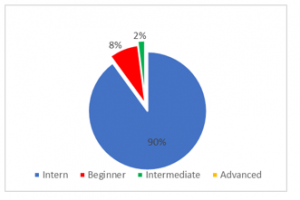
Figure 15: Responses to first question of survey 2
We can see 90% students look for intern position when they are in the fourth year of bachelor’s study, as internship is the first step towards the journey of employment. There are some students who start working since the first or second year of bachelor. It is the result of this that in the fourth year, they start looking for beginner or intermediate level of jobs. According to our survey, 8% look for beginner level, 2% for intermediate level and no one for advanced level.
Result for the question 2: “From which year do you start looking for jobs?” is shown in Figure 16.

Figure 16: Responses to second question of survey 2
From the Figure 16, we can see 50% of students start looking for jobs from 4th year onwards. Similarly, 32% from 3rd year, 12% from 2nd year and only 6% from 1st year. This result shows as students’ progress towards the end of their study, they more actively start looking for jobs. Especially, the numbers increase rapidly towards third and fourth year.
Survey 3
This survey was conducted after the system was brought in use to know if it has served its purpose for which it was developed. 280 students participated in this survey comprising the third- and fourth-year students from the faculty of bachelor in computer, electronics and communication, electrical and civil engineering
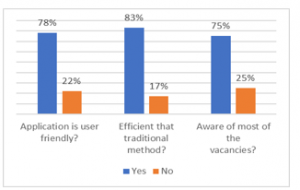
Figure 17: Responses to survey 3
From Figure 17, we can see 78% students found this application user friendly and 83% found it more efficient than the traditional method of hiring. Similarly, 75% who used this system were aware of most of the jobs posted, of their concern. This is actually a good number as it was only 40% in case of traditional method. Looking at these numbers, we feel the system has at least served its purpose to some extent.
Analysis and visualization of number of vacancies received over the period of one-year (i.e. from 2018/08/01 to 2019/07/31) using choropleth map:
5.2. Province wise analysis
From the Table 1 and Figure 18, we can see that Bagmati Province is way ahead in terms of generating employment opportunities. Then comes Province 5, Province 2 and Province 1 respectively. The remaining two provinces i.e. Karnali and Sudurpashchim provinces have not contributed in job openings through this system over the given period of time. This is because many industries and services sectors are situated in the Bagmati province. Also, its contribution to the GDP of the country is much higher than the other provinces.
Table 1: Number of vacancies across provinces of Nepal (Tabular representation)
| Province | Number |
| Bagmati | 77 |
| 5 | 15 |
| 2 | 12 |
| 1 | 11 |
| Gandaki | 4 |
| Karnali | 0 |
| Sudurpashchim | 0 |

Figure 18: Number of vacancies across provinces of Nepal (Graphical representation)
5.3. District wise analysis
From the Table 2 and Figure 19, we can see Kathmandu district has the highest job openings over the period of one year. Also, we received job vacancies from only 16 out of 77 districts of Nepal. We received zero vacancy from the districts not mentioned in the Table 2. If we exclude Kathmandu and Lalitpur from the list we barely received vacancies from the other districts. This shows the concentration of economy within only few districts of Nepal.
Table 2: Number of vacancies across districts of Nepal (Tabular representation)
| District | Number |
| Kathmandu | 42 |
| Lalitpur | 24 |
| Rupandehi | 8 |
| Morang | 7 |
| Dhanusa | 5 |
| Chitwan | 5 |
| Dang | 5 |
| Bhaktapur | 4 |
| Kaski | 4 |
| Sunsari | 3 |
| Parsa | 3 |
| Mahottari | 2 |
| Bara | 2 |
| Makwanpur | 2 |
| Kapilvastu | 2 |
| Bhojpur | 1 |

Figure 19: Number of vacancies across districts of Nepal (Graphical representation)
Visualization (using word cloud) of various types of skills that were required for the jobs we received over the period of one year (i.e. from 2018/08/01 to 2019/07/31):

Figure 20: Word cloud of skills that were mentioned for job vacancies
We can visualize in Figure 20 that skills like PHP, SQL, HTML, Python, Web design, Graphics design and so on were more in demand at least over that one-year period.
6. Conclusions and recommendations
We decided to build this e-recruitment system seeing the problems that were faced by the students of our campus. The main idea was to help students overcome the communication gap with the companies and to provide fair chance to every student in the campus to showcase their talent and skills in order to grab any job opportunity that comes their way. And to achieve this, we thought of building a system which could bring both the students and the companies on a single platform so that they can communicate directly and in an organized manner.
This system fulfills many of its purpose. But as it is said nothing is perfect, this system has also some shortcomings which we hope to improve in the upcoming future. We can make a provision to read the information of CV in PDF form, when uploaded to the system instead of enforcing the new users to fill the information manually. We can add blogging feature with advanced functionalities to develop it as a social hub where one can help others in finding a job. We can add online test features to verify the skills mentioned by students in their profile. We can improve the job recommendation using some advanced machine learning algorithms. The notification features informing the students about the job match can be improved. Some inbuilt data analysis tools can be added to provide insights on the current job scenario. Also, feature regarding the sharing of CV on different platforms through this platform can be added.
- V. Yadav, U. Gewali, S. Khatri, S.R. Rauniyar, A. Shakya, “Smart Job Recruitment Automation: Bridging Industry and University,” in International Conference on Artificial Intelligence for Transforming Business and Society, AITB 2019, 1-6, 2019, doi:10.1109/AITB48515.2019.8947445.
- E. Galanaki, “The decision to recruit online: A descriptive study,” Career Development International, 07, 243-251, 2002, doi:10.1108/13620430210431325.
- O. Shafique, “Recruitment in the 21 st century,” Interdisciplinary Journal of Contemporary Research in Business, 04(02), 887-901, 2012.
- J. Dorn, T. Naz, Integration of Job Portals by Meta-search, 401-412, 2007, doi:10.1007/978-1-84628-858-6_44.
- L. Khanam, M.A. Uddin, M.A. Mahfuz, “Students’ Behavioral Intention and Acceptance of E-recruitment System: A Bangladesh Perspective,” Proceedings of the 12Th International Conference on Innovation and Management, 1297-1303, 2015 doi:631.
- E. Parry, S. Tyson, “An analysis of the use and success of online recruitment methods in the UK,” Human Resource Management Journal, 18(03) 257-274, 2008, doi:10.1111/j.1748-8583.2008.00070.x.
- M.G.G. Ventura, R.P. Bringula, “Effectiveness of online job recruitment system?: evidence from the university of the east,” IJCSI International Journal of Computer Science Issues, 10(04), 152-159, 2013.
- A. Matas, “Internet becomes an on-line opportunity for employers and job hunters,” The Washington Post, H2, Nov. 7, 1993.
- R. Ramaabaanu, & M. Saranya, “Importance and Problems of E- Recruitment,” International Journal of Research (IJR), 01(09), 2014.
- A.J. du Plessis, H. Frederick, “Effectiveness of e-recruiting: empirical evidence from the Rosebank business cluster in Auckland, New Zealand,” Science Journal of Business Management, 2012, 1-19, 2012, doi:10.7237/sisa/126.
- S. Mauno, U. Kinnunen, M. Ruokolainen, “Job demands and resources as antecedents of work engagement: A longitudinal study,” Journal of Vocational Behavior, 70(01), 179-171, 2007, doi:10.1016/j.jvb.2006.09.002.
- M.O. Fred, U.M. Kinange, “Effectiveness of E-Recruitment in Organization Development,” Management and Economic Journal, 02(04) 2018, 294-301.
- B. Raghavendra, C. Priyanka, G. Chaithanya, “A study on E recruitment,” International Journal of Advance Research in Science and Engineering, 07(03), 2018.
- R. Rani, “E-Recruitment and its impact upon job seekers: A contemporary approach,” International Journal of Advanced Research and Innovative Ideas in Education, 02(04), 2016.
- Y. Gupta, “Literature review on E-Recruitment: A step towards paperless HR,” International Journal of Advance Research in Computer Science and Management Studies, 04(01), 2016.
- F. Ramadhani, M. Zarlis, “Analysis of e-Recruitment System Design,” International Journal of E-Education, e-Business, e-Management and e-Learning, 09, 38–45.
- M.R. Karim, M.S. Miah, A. Khatun, “E-Recruitment in Practice: A Study on Jobseekers’ Perception in Bangladesh,” Global Disclosure of Economics and Business, 04, 2015, doi:10.18034/gdeb.v4i1.150.
- R. et al Patel, “E-Recruitment Challenges and Methods used in Modern Organization,” International Journal of Advance Research in Computer Science and Management Studies, 04(12), 2016.
- P. Manjare, R. Munde, “An Effective Job Recruitment System Using Content-based Filtering,” International Research Journal of Engineering and Technology(IRJET), 04(03) 2017.
- B.R. Poudel, “Online Recruitment: A Cognitive Perspective of Job Seekers in Nepal,” Journal of Business and Social Sciences, 02(01) 2018, doi:10.3126/jbss.v2i1.22823.
- K. Kukich, “Techniques for Automatically Correcting Words in Text,” ACM Computing Surveys (CSUR), 1992, doi:10.1145/146370.146380.
